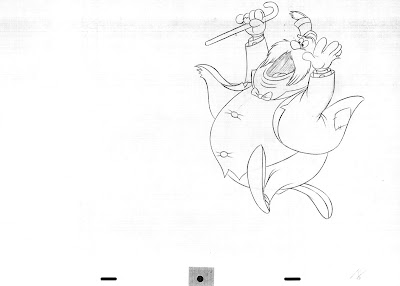I believe the character sketches on this pre-animation model sheet of the Walrus from Alice in Wonderland are by Joe Rinaldi. They are terrific and scream out to be animated.
However there is one thing that's been puzzling me: How come that the animal specific tusks were left out in the design?
It's almost like drawing an elephant without a trunk, or a cow without an utter. By omitting the tusks the character ends up looking a bit more generic, this could be a Disney version of a bear or a dog.
When you look at the guy below, you can see what I am talking about.
John Tenniel's original illustrations for the Alice books show an anthropomorphic walrus whose design is definitely based on a real one.
A couple of production cels, showing Disney's high standards when it comes to character colors.
Ward Kimball animated most if not all of the Walrus' scenes. Here he runs away from the Carpenter, who just found out that his buddy ate all the oysters. "The time has come..."
This is your typical cartoon take off. The character is running in place in anticipation of the actual get away. Yet Kimball manages to add a lot of personality to this boisterous movement.





















What I love most about the Walrus as a character is that he's something of a walking contradiction. He speaks in a very upper-class manner, but he dresses in worn-out clothing. He puts on very pompous airs, but he's underhanded and gluttonous.
ReplyDeleteThis whole segment is a lot of fun, particularly when the the Walrus is trying to coerce the oysters into joining him for dinner.
Maybe you were intended to see the tusks through the shape of his mustache?
ReplyDeleteHave you see Alice through the looking Glass, it looks like there's 3 movies of Alice 1 an animate version and 2 live action.
ReplyDeleteI know that Tim Burton vision of Alice in Wonderland looks like Charly and the Chocolate Factory some landscape are a little bit dark and some are light wen she is going to the white queen.
ReplyDeleteActually, those model sheets look more like something that Bill Peet had drawn- at least, to my eyes.
ReplyDeleteThis is something I always wondered as a child. I assume that it may have been because they may have been difficult to animate in a pre-computer or even pre-Xerox era, or because they would have got in the way of his expressions. However, it hardly seems unthinkable and unachievable for Disney animators to have included even just some small tusks, especially when the walrus character in the old Woody Woodpecker cartoons had tusks despite being made by generally less skilled animators on a much more modest budget.
ReplyDeletewhy do you think the tusks would have been too difficult to draw?
DeleteI'm not an expert, so it's only speculation, but they could be a bit like deer antlers as they're completely static.
DeleteMust've thought the walrus vibe would come across in the "whiskers," rotund body, and flipper feet....
ReplyDeleteI can tell from Kimball's animation that when the Walrus does expressions where his eyes meant being sneaky and "devilish", it feels like he was doing such interesting characters from the early fifties: the past (Lucifer from "Cinderella"), present (the Walrus) and future (the Indian Chief from "Peter Pan").
ReplyDeleteIt's to bad the Walrus dosent appear in the live action of Alice in Wonderland and Through the Looking Glass.
ReplyDeletesince it's from Kimball, I would guess it's a walrus because we call it a walrus...hehe. I agree with the other poster.The design was good enough with the mustache that they didn't need them.Tusks would have complicated the dialogue to no end and competed with the mustache for readability and real estate with the color. poor little oysters.
ReplyDeleteMaybe the tusks might have been too much of a distraction to the viewer. With the amount of expression of the face and all. Regardless, this is one of my favorite characters. Alice and Wonderland is one of the movies that makes me want to go back to Disneyland all the time.
ReplyDeleteThe pencil test of these drawings (compared to the final color animation) -
ReplyDeletehttps://www.youtube.com/watch?v=tA1vxShQXRE
If you notice in the very last scene of 'Alice in Wonderland" when they are chasing her to the door, they reveal the shape head. The Queen, the Caterpellar, the Walrus, Tweedle Dee and Tweedle dumb use the exact same head shape.
ReplyDeleteI believe with the "tusks" they were free to do whatever they thought would be an appealing design. The mustache itself gave the character a sinister look enough already.
ReplyDelete